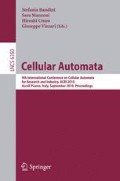Abstract
We modeled a multi-agent system as a two-dimensional Cellular Automata and searched for a rule in order to solve the all-to-all communication task in shortest time. The rule contains two finite state machines (FSM) controlling the behavior of the uniform agents. The moving FSM controls the moving actions and the color FSM controls the changing of the cell’s color. Colors are used for indirect communication. In addition the agents receive an acknowledgment whenever they meet and communicate successfully. The FSMs were evolved by a genetic algorithm. It could be shown that acknowledging and especially coloring increases the performance of the agents. Certain initial configurations cannot be solved without coloring. Even with coloring, symmetric configurations cannot be solved when the initial colors are the same.
Access this chapter
Tax calculation will be finalised at checkout
Purchases are for personal use only
Preview
Unable to display preview. Download preview PDF.
References
Olfati-Saber, R., Fax, J.A., Murray, R.M.: Consensus and cooperation in networked multi-agent systems. Proceedings of the IEEE 95, 215–233 (2007)
Lin, J., Morse, A.S., Anderson, B.D.O.: The Multi-Agent Rendezvous Problem. An Extended Summary. In: Cooperative Control. LNCS, vol. 309, pp. 257–289. Springer, Heidelberg (2005)
Principe, G., Santoro, N.: Distributed algorithms for autonomous mobile robots. In: 4th IFIP Int. Conf. on TCS. IFIP, vol. 209, pp. 47–62. Springer, Heidelberg (2006)
Ediger, P., Hoffmann, R.: Optimizing the creature’s rule for all-to-all communication. In: EPSRC Workshop Automata-2008. Theory and Applications of Cellular Automata, Bristol, UK, June 12-14, pp. 398–410 (2008)
Hoffmann, R., Ediger, P.: Evolving Multi-creature Systems for All-to-All Communication. In: Umeo, H., Morishita, S., Nishinari, K., Komatsuzaki, T., Bandini, S. (eds.) ACRI 2008. LNCS, vol. 5191, pp. 550–554. Springer, Heidelberg (2008)
Ediger, P., Hoffmann, R.: Solving All-to-All Communication with CA Agents More Effectively with Flags. In: Malyshkin, V. (ed.) PACT 2009. LNCS, vol. 5698, pp. 182–193. Springer, Heidelberg (2009)
Halbach, M., Hoffmann, R., Both, L.: Optimal 6-state algorithms for the behavior of several moving creatures. In: Yacoubi, S.E., Chopard, B., Bandini, S. (eds.) ACRI 2006. LNCS, vol. 4173, pp. 571–581. Springer, Heidelberg (2006)
Sipper, M.: Evolution of Parallel Cellular Machines, The Cellular Programming Approach. LNCS, vol. 1194. Springer, Heidelberg (1997)
Sipper, M., Tomassini, M.: Computation in artificially evolved, non-uniform cellular automata. Theor. Comput. Sci. 217(1), 81–98 (1999)
Komann, M., Mainka, A., Fey, D.: Comparison of evolving uniform, non-uniform cellular automaton, and genetic programming for centroid detection with hardware agents. In: Malyshkin, V.E. (ed.) PaCT 2007. LNCS, vol. 4671, pp. 432–441. Springer, Heidelberg (2007)
Dijkstra, J., Jessurun, J., Timmermans, H.J.P.: A multi-agent cellular automata model of pedestrian movement. In: Schreckenberg, M., Sharma, S.D. (eds.) Pedestrian and Evacuation Dynamics, pp. 173–181. Springer, Heidelberg (2001)
Nagel, K., Schreckenberg, M.: A cellular automaton model for freeway traffic. J. de Physique 2, 2221 (1992)
Mesot, B., Sanchez, E., Peña, C.A., Perez-Uribe, A.: SOS++: Finding smart behaviors using learning and evolution. In: Standish, R., Bedau, M., Abbass, H. (eds.) Artificial Life VIII: The 8th International Conference on Artificial Life, pp. 264–273. MIT Press, Cambridge (2002)
Halbach, M.: Algorithmen und Hardwarearchitekturen zur optimierten Aufzählung von Automaten und deren Einsatz bei der Simulation künstlicher Kreaturen. PhD thesis, Technische Universität Darmstadt (2008)
Author information
Authors and Affiliations
Editor information
Editors and Affiliations
Rights and permissions
Copyright information
© 2010 Springer-Verlag Berlin Heidelberg
About this paper
Cite this paper
Ediger, P., Hoffmann, R. (2010). All-to-All Communication with CA Agents by Active Coloring and Acknowledging. In: Bandini, S., Manzoni, S., Umeo, H., Vizzari, G. (eds) Cellular Automata. ACRI 2010. Lecture Notes in Computer Science, vol 6350. Springer, Berlin, Heidelberg. https://doi.org/10.1007/978-3-642-15979-4_3
Download citation
DOI: https://doi.org/10.1007/978-3-642-15979-4_3
Publisher Name: Springer, Berlin, Heidelberg
Print ISBN: 978-3-642-15978-7
Online ISBN: 978-3-642-15979-4
eBook Packages: Computer ScienceComputer Science (R0)

